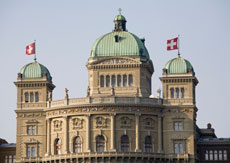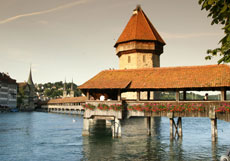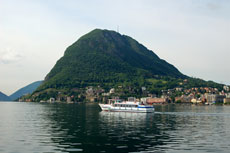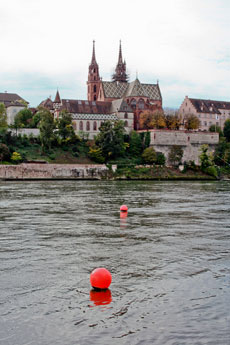
Swiss Cities are both trendy and traditional
visit the most beautiful Swiss towns:
Bern – The capital of Switzerland

Bern is the capital of Switzerland, named after bears which can still be seen in pits at “Bärengraben”. UNESCO has recognized Bern as a Cultural Heritage Site. For all its political status, Bern is a tiny city of barely 130’000 people.
The Zytglogge Tower is one of the landmarks of the old city of Bern. Originally it was the western city gate to Bern. Today, the astronomic clock , from the 16th century is a much admired attraction.
The Paul Klee Centre is one of Bern’s modern museum with the largest Klee collection in the world – almost half of the Bernese artist’s output is here with 3000 paintings and 50000 drawings. The architecture of the centre is also fascinating: it consists of three translucent fluted mounds made of glass and steel, and was designed by star architect Renzo Piano.
Einsteinhaus - the genial physicist lived in Bern when, in 1905, he developed the formula for the theory of relativity. The Einstein exhibition shows interesting facts about the life of the man with the wild hair, in an area of 1’200 m2.
Zurich – The picturesque city and the city of money

Zurich is the biggest Swiss city, but is still relatively small with fewer than 400’000 people living in the city. Zurich is regulary designated the city with the best quality of life in the world. It also harbours the world headquarters of several Swiss banks and of the FIFA.
The city on the River Limmat offers art and culture, trends and lifestyle, culinary delights and natural beauty – all in one. The River Limmat flows towards a crystal-clear lake and distant snowy peaks.
The church of Grossmünster (great minster) dominates Zurich’s skyline with its impressive twin towers. Nearby rise the graceful spires both of St Peter’s, featuring the largest clock face in Europe, and the Fraumünster, a medieval church decorated in this century with beautiful stained glass by Marc Chagall.
The long curving Bahnhofstrasse follows the ancient course of the western city wall, and is now one of Europe’s most prestigious shopping streets, packed with jewellers and designer boutiques.
Geneva – The smallest metropolis in the world

Geneva is the home of over 200 organizations like the Red Cross or the European Head Quartes of the United Nations. From its profile in world events, you’d imagine a megalopolis on the scale of London or New York, but Geneva is little more than town-sized.
The river Rhône flows out of Lake Geneva flanked on one side by the Jura ridges and on the other by the first peaks of the Savoy Alps as well as Mont-Blanc a little further south. On the shores of Lake Geneva some elegant white wines are produced in small vineyards, often run by families over generations.
Lucerne – The prettiest city

Lucerne is truly the most beautiful Swiss city and is also the most visited of the Swiss cities. You can walk over the “Kappellbrücke” (The Chapel Bridge), one of the oldest wooden bridges in Europe.
The Glacier Garden is just a few blocks away from the old town of Lucerne. It is known by the famous lion which is carved into the rock at the entrance to Glacier Garden. In the Glacier Garden you see what Lucerne might have looked like in the last ice age.
In the Swiss Tansport Museum of Lucerne you can spend a very interesting and active afternoon.
The past, present and future of transport and mobility on land, sea and in the air; the principles of (tele-) communication – these are the main themes. The IMAX Theatre (uses a huge screen and a special film format) is on site.
Enjoy a boat trip on Lake Lucerne – the scenic beauty of the lake can be discovered on the many different cruises offered by paddlewheel steamers and motor vessels.
The Culture and Convention Centre Lucerne (KKL) ranks today as one of the most spectacular modern buildings in Switzerland. French architect Jean Nouvel combined design and aesthetics to create the new landmark of the city of Lucerne. The concert halls offers excellent acoustic for the numerous high-quality classical concerts held there – be aware, tickets are sold out quickly !
Side trip: Mount Rigi
For a longtime Mount Rigi (1,680m/5,510 ft.) has been the most famous mountain in the country. You can travel to the foot of the mountain by taking a 55-minute trip by steamboat from Lucerne to Vitznau, a small resort on the northern shore of the lake. The rack railway from Vitznau to Rigi-Kulm was the first cog railway in Europe, built in 1871. The trip from Vitznau to the top takes 40 minutes. There are a dozen departures a day during high season.
Lugano – The mediterranean city

Lugano has a temperate microclimate just like Locarno, the other city in the southern part of Switzerland, and has as much hours of sun as Southern Europe. It borders Italy too which explains why Lugano clearly has an Italian character combining Italian vitality and charm with Swiss efficiency and tidiness. It is only half an hour from Milan in Italy.
Basel – The industrial city

Basel has made it’s name in the pharmaceutical industry. Big companies like Novartis and Roche are known worldwide. Basel combines international flair with small-town charm and a special spirit.
The city at the Rhine-knee in the three-country corner to Germany and France is brimming with charm. The Rhine River port is Switzerland’s only outlet to the sea. Basel’s historic centre – dominated by the awe-inspiring Münster– is definitely worth seeing.
The Foundation Beyeler, currently comprising around 200 works, is a collection of modern art. Star architect Renzo Piano has created an ideal building for presenting works from famous impressionists and modern artists.